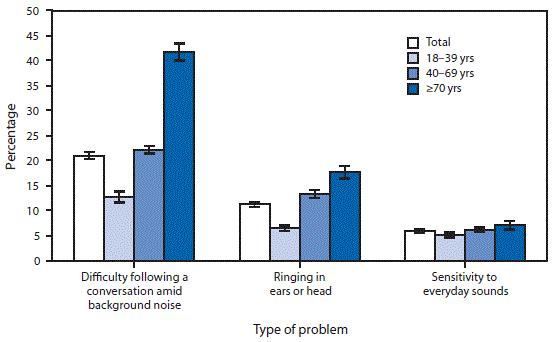QuickStats: Percentage of Adults with Selected Hearing Problems,* by Type of Problem and Age Group — National Health Interview Survey,† United States, 2014

* Percentages shown with 95% confidence intervals. Based on responses of "Always," "Usually," or "About half the time" to the question, "How often do you find it difficult to follow a conversation if there is background noise, for example, when other people are talking, TV or radio is on, or children are playing close by?" and positive responses to questions, "During the past 12 months, have you been bothered by ringing, roaring, or buzzing in your ears or head that lasts for 5 minutes or more?" and "Some people are bothered by everyday sounds or noises that don't bother most people. Do everyday sounds, such as from a hair dryer, vacuum cleaner, lawnmower, or siren, seem too loud or annoying to you?" These questions refer to symptoms of high-frequency hearing loss, tinnitus, and hyperacusis, respectively.
† Estimates are based on household interviews of a sample of the noninstitutionalized U.S. civilian population aged ≥18 years and are derived from the National Health Interview Survey sample adult component.
In 2014, an estimated 21.0% of adults aged ≥18 years had difficulty following a conversation amid background noise, 11.2% had ringing in the ears, and 5.9% had sensitivity to everyday sounds. Adults aged ≥70 years were more than three times as likely to have difficulty following conversation amid background noise, and more than twice as likely to have ringing in the ears, but only slightly more likely to have sensitivity to everyday sounds, compared with adults aged 18–39 years.
Source: National Health Interview Survey, 2014 data. Available at http://www.cdc.gov/nchs/nhis.htm.
Reported by: Carla E. Zelaya, PhD, vdn3@cdc.gov, 301-458-4164; Jacqueline W. Lucas, MPH; Howard J. Hoffman, MA.
Alternate Text: The figure above is a bar chart showing that in 2014, an estimated 21.0% of adults aged ≥18 years had difficulty following a conversation amid background noise, 11.2% had ringing in the ears, and 5.9% had sensitivity to everyday sounds. Adults aged ≥70 years were more than three times as likely to have difficulty following conversation amid background noise, and more than twice as likely to have ringing in the ears, but only slightly more likely to have sensitivity to everyday sounds, compared with adults aged 18-39 years.
Use of trade names and commercial sources is for identification only and does not imply endorsement by the U.S. Department of
Health and Human Services.
References to non-CDC sites on the Internet are
provided as a service to MMWR readers and do not constitute or imply
endorsement of these organizations or their programs by CDC or the U.S.
Department of Health and Human Services. CDC is not responsible for the content
of pages found at these sites. URL addresses listed in MMWR were current as of
the date of publication.
All MMWR HTML versions of articles are electronic conversions from typeset documents.
This conversion might result in character translation or format errors in the HTML version.
Users are referred to the electronic PDF version (http://www.cdc.gov/mmwr)
and/or the original MMWR paper copy for printable versions of official text, figures, and tables.
An original paper copy of this issue can be obtained from the Superintendent of Documents, U.S.
Government Printing Office (GPO), Washington, DC 20402-9371;
telephone: (202) 512-1800. Contact GPO for current prices.
**Questions or messages regarding errors in formatting should be addressed to
mmwrq@cdc.gov.
 ShareCompartir
ShareCompartir


